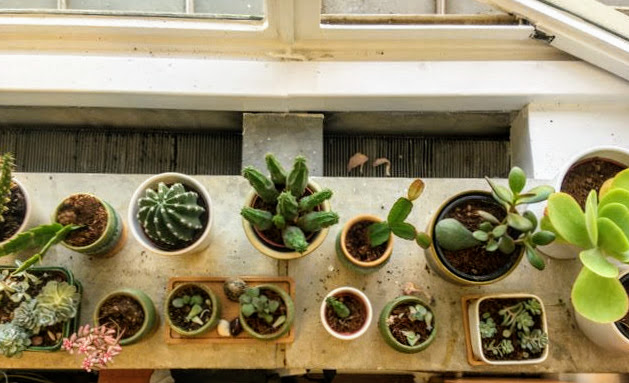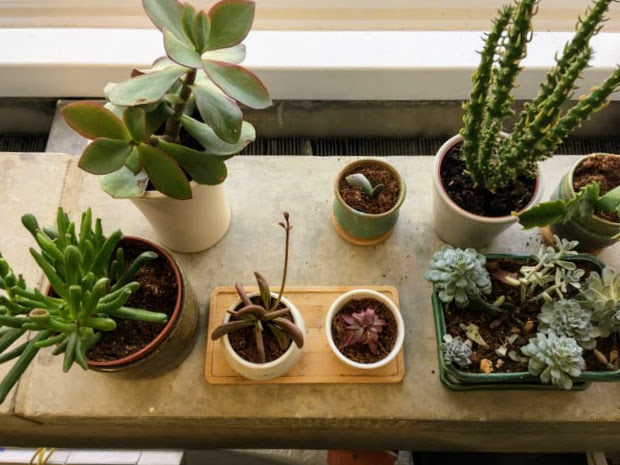For Environment Week the Library Green Group has taken over the Library’s social media, and invited Jules Bristow to blog about her office plants.

I have a confession to make. The admin office was expensively renovated last summer to give us more space and a more logical way of integrating the team, but my favourite part of it remains my long sunny windowsill.
When I started this job the windowsill was the first thing I spotted in the office, and I immediately made plans to start smuggling in some of the light-loving succulents that were spilling over from my windowsills at home. Two and a half years later and I have almost filled the windowsill and started covering the filing cabinets and bookshelves with orchids and other more shade-loving plants.
I was asked to write this blog post for Environment Week on the benefits of indoor plants in tackling indoor air pollution. While most of us are familiar with outdoor air pollution – the greenhouse gases and smog particulates produced by combustion – we are often much less aware of the dangers of indoor air pollution. We spend up to 90% of our lives indoors, where the concentrations of volatile organic compounds (VOCs) are up to 5 times higher in than in outdoor air. These particles come from aerosol sprays such as air fresheners and cleaning products, paints, polishes and fire retardants in furniture and carpets and are a particular problem in office environments where photocopiers and laser printers in particular are known to emit huge quantities of VOCs as well as ozone. These compounds can cause lung problems such as asthma and emphysema, as well as having broader harmful effects throughout the body.
We are just beginning to learn about the threats these compounds pose, so while in the long term we should be trying to reduce the amount of them released by the buildings we inhabit and the products we use in the short term the best we can do is to try to remove them from indoor air. Studies have shown that plants and soil microorganisms are effective at absorbing VOCs and even heavy metals from the air. Certainly on the beautiful Sussex campus you’re likely to find the highest number of plants outdoors, so your best bet to improve indoor air quality is to open a window. Unfortunately though many University buildings were intentionally designed with poor airflow to prevent fires from spreading or to save on heating costs so there are many areas where this may be possible. Your second best option is to bring some plants inside.
I’d like to believe that my little office garden brings about a small improvement in the air quality in the admin office. I must admit however that, although this is the reason I was asked to blog, it isn’t my main reason for having office plants. Whatever their effect on indoor air pollution, I have them simply because they make me happy.

There is scientific evidence that caring for plants or even just being in spaces with plants can reduce stress and improve feelings of wellbeing. I find these findings entirely unsurprising – as a species we evolved in environments filled with subtle shades of green and elegant organic shapes and are adapted to process these stimuli, rather than the harsh lines and blinking lights we surround ourselves with in modern life, the salience of which constantly keeps our brains on high alert. I always find it fascinating walking through a modern city of angular steel and gleaming glass to see the number of balconies adorned with plants. Even as we try to isolate ourselves from nature it seems we crave it on some deep subconscious level. Watching new leaves and flower buds appearing and unfurling on my plants as they grow and flourish, the colours that change through the season with the intensity of the light, soothes me and keeps me grounded, reminds me of what’s important and unchanging in the world beyond any petty stresses or frustrations I may experience in my day to day.
There is something immensely comforting too in the way that if cared for properly, provided with sunlight and water and a little dirt, a plant will grow and flourish, may even split or be divided into more plants which can be shared and spread joy. We live in a society who’s underlying narrative is one of scarcity, austerity and budget cuts. Every year it seems that living gets more expensive, there seems to be less to go around and we are told we need to compete to get it. Plants help to remind me that there is abundance in the natural world even if not in the systems we create to govern our lives, and that, like knowledge, it should be shared widely and generously. This, ultimately, is why I need plants in my life and why I feel they belong in Libraries.

Pingback: My office jungle – Tangled Bank